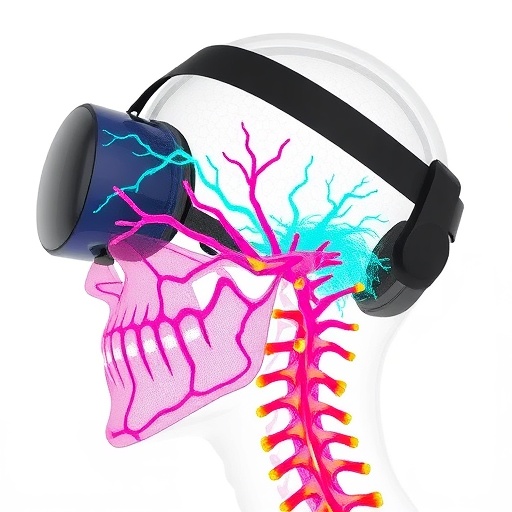In a groundbreaking study published in the journal Plant Phenomics, researchers led by Dirk N. Baker from Forschungszentrum Jülich GmbH have introduced a novel virtual reality application known as VRoot, designed expressly for the intricate task of root system architecture (RSA) reconstruction. This innovative technology showcases a significant advancement in the field of plant phenotyping, particularly with its applicability to the complexities of 3D root data visualization. The study’s findings emphasize the critical nature of accurate RSA data, which is essential for improving agricultural sustainability and resilience in the face of environmental stresses.
The research centers around the challenges faced by current methods of root data extraction, particularly from non-invasive 3D imaging techniques such as magnetic resonance imaging (MRI). While MRI provides a means to visualize root systems without disturbing plant growth, the process of translating these images into usable digital models has remained a formidable hurdle. Conventional automatic extraction tools frequently misinterpret root structures due to the presence of imaging noise, soil artifacts, or incomplete visibility. The reliance on manual corrections by experts not only adds to the time and labor required but often leaves the spatial perception limited, hampering effective interaction with the data.
To address these issues, the team developed VRoot as an immersive VR application, enriching the user experience through enhanced spatial interaction with 3D volumetric root data. Participants utilized head-mounted displays and motion-tracked controllers to navigate through MRI-derived soil column models, empowering them to trace root paths and perform real-time adjustments in an expansive three-dimensional workspace. The results of this comprehensive study revealed that VRoot significantly outperformed NMRooting—a conventional desktop-based root extraction tool—in terms of F1 scores, particularly when faced with datasets corrupted by water-induced noise.
The study notably involved untrained participants tasked with root tracing under both normal and noisy conditions. Intriguingly, those using VRoot not only achieved higher F1 scores but also provided more accurate measurements of critical parameters such as root length and inter-lateral distance. These metrics are pivotal for understanding root development and health, providing insights into plant performance under various environmental scenarios. The improvements in precision and recall underscored the potential of VRoot to reduce tracing errors while enhancing overall user satisfaction.
Usability assessments conducted during the study employed widely recognized tools like the System Usability Scale. These evaluations indicated a strong preference for VRoot, particularly when contrasting experiences with noisier datasets. Despite initial concerns regarding depth perception and navigation within the VR environment, quick training sessions effectively mitigated these challenges, allowing participants to harness the full capability of the technology. This indicates not just the feasibility of VR in enhancing scientific research but also its practical application in training novices in complex tasks.
The implications of VRoot extend far beyond the laboratory. By facilitating more accurate reconstructions in demanding conditions, this VR technology opens doors for extensive applications in diverse soil types and varying moisture levels, both of which tend to disrupt automated algorithms. This capability is particularly relevant for functional-structural plant modeling, where precise data on root systems are crucial for simulating water and nutrient uptake. The potential benefits for plant breeders, crop scientists, and soil ecologists are vast, enabling a more nuanced understanding of how root traits correlate with plant performance under real-life stresses.
As the research progresses, the insights provided by VRoot may herald a new era in root phenotyping, where technology and biology coalesce to enhance agricultural practices. It reflects a broader trend of utilizing immersive technologies in research settings, pushing the boundaries of how scientists visualize and interpret complex biological data. With the ability to accurately map out root system architecture, researchers can better predict crop yields and improve plant resilience to environmental challenges, laying the groundwork for future innovations in sustainable agriculture.
Moreover, the funding supporting this substantial research underscores the commitment of various institutions towards advancing agricultural science through innovative technological applications. The Gauss Centre for Supercomputing, the EUROCC2 project funded by the European High-Performance Computing Joint Undertaking, and the German Research Foundation have all played crucial roles in making this research a reality. Their contributions represent a growing recognition of the importance of interdisciplinary approaches to tackling significant global issues such as food security and sustainable resource management.
In summary, the introduction of VRoot is not merely a technical achievement; it marks a pivotal moment in the landscape of plant phenotyping and root system analysis. The study provides compelling evidence that the integration of virtual reality into scientific methodologies can yield substantial improvements in accuracy and user experience. As the agricultural sector faces increasing pressures from climate change and resource shortages, innovations like VRoot will play an essential role in the global pursuit of sustainable farming practices.
The potential for VRoot to streamline root phenotyping processes demonstrates a valuable interplay between technology and ecological research, fostering a new generation of tools for scientists and practitioners alike. The future of agriculture may well depend on harnessing such technologies, paving the way for smarter, more resilient crop systems that can thrive in the face of adversity.
Subject of Research: Root system architecture reconstruction
Article Title: VRoot: A VR-Based application for manual root system architecture reconstruction
News Publication Date: 26-Mar-2025
Web References:
References: DOI: 10.1016/j.plaphe.2025.100013
Image Credits:




